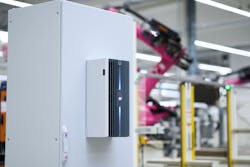A critical aspect of many automation enclosures is their ability to protect the electronic components inside and keep them cool in harsh industrial environments. As noted in Automation World’s recent feature on enclosures, cooling systems are now commonplace in many enclosures as the number of heat-generating electronics used in control applications has mushroomed over the past several years.
With this operating reality in mind, Rittal has introduced its new Blue e+ S smart cooling units for enclosures. These cooling units feature lower output categories of .3 kW, .5 kW, and 1 kW, and have been designed for efficiency to provide energy savings, minimize CO2 emissions, and lower associated operating costs.
Rittal first introduced its Blue e+ range of enclosure cooling units seven years ago. The new Blue e+ S units are based on the same design and energy saving principles but have added smart capabilities that provide additional energy and cost savings. These additional savings come via the combination of a heat pipe with inverter-controlled components.
According to Rittal, the heat pipe works without a compressor, expansion valve, or other regulating elements, thereby eliminating the need for electrical energy except to operate the fan. Depending on the thermal energy generated in the enclosure and the current ambient temperature, cooling can be performed with the heat pipe alone. The additional compressor cooling only operates if a large amount of heat must be dissipated from the enclosure or if the ambient temperature is very high. When the compressor does operate, the inverter-controlled drive automatically adjusts depending on the cooling requirements to maintain a constant temperature in the enclosure and deliver higher energy efficiency.
The Blue e+ S also reportedly reduces the carbon footprint of the enclosure by using the R-513A refrigerant, which has a Global Warming Potential (GWP) that is 56% lower than those used in comparable cooling units.
The new cooling units can also be monitored using Rittal's new Smart Service Portal to optimize service processes through predictive maintenance. The Blue e+ S units are also equipped with Near Field Communication (NFC), enabling them to communicate with mobile devices using the Rittal Scan & Service app.
Sponsored Recommendations
Leaders relevant to this article:


